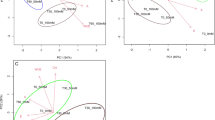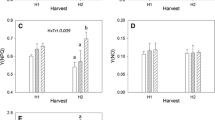Summary
Potted cuttings of a 12-year-old Picea abies tree were fumigated with ozone, 100 or 300 μg O3· m−3 (50 or 150 ppb O3) being added to charcoal-filtered air during the 1985 growing season for a total of 1215 h. The wax structure of ozone-fumigated needles was no different from that of controls. Because flattened wax structures and fused wax fibrils also occurred in controls, these phenomena could not serve as bioindications for the ozone concentrations applied. A smooth layer was found beneath the soluble wax layer and covered needle surface and stomatal openings of ozone-fumigated needles to a greater extent than in controls. Wax quantity was considerably reduced by fumigation with 300 μg O3 · m−3. Leaf pigments (as extracted with the wax) were less abundant in needles treated with 300 μgO3; the smooth layer probably contributed to the impeded extraction of pigments.
Similar content being viewed by others
References
Crossley A, Fowler D (1986) The weathering of Scot's pine epicuticular wax in polluted and clean air. New Phytol 103: 207–218
Elstner EF, Osswald W (1984) Fichtensterben in “Reinluftgebieten”: Strukturresistenzverlust. Naturwiss Rundsch 2: 52–61
Günthardt MS, Wanner H (1982) Veränderungen der Spaltöffnungen und der Wachsstruktur mit zunehmendem Nadelalter bei P. cembra L. und P. abies (L.) Karsten an der Waldgrenze. Bot Helv 92: 47–60
Günthardt MS (1985) Entwicklung der Spaltöffnungen und der epicuticulären Wachsschicht bei P. cembra und P. abies. Bot Helv 95: 5–12
Huttunen S, Laine K (1983) Effects of air-borne pollutants on the surface wax structure of P. sylvestris needles. Ann Bot Fennici 20: 79–86
Juniper BE, Cox GC (1973) The anatomy of the leaf surface: the first line of defence. Pestic Sci 4: 543–561
Keller T, Häsler R (1987) Some effects of long-term ozone fumigation on Norway spruce. I. Gas exchange and stomatal response. Trees 1: 129–133
Magel E, Ziegler H (1986) Einfluss von Ozon und saurem Nebel auf die Stuktur der stomatären Wachspfropfen in den Nadeln von P. abies (L.) Karsten. Forstwiss Cbl 105: 234–238
Riding RT, Percy KE (1985) Effects of SO2 and other air pollutants on the morphology of epicuticular waxes on needles of P. strobus and P. banksiana. New Phytol 99: 555–563
Sauter JJ, Voss JU (1986) SEM-observations on the structural degradation of epistomatal waxes in P. abies (L.) Karst. — and its possible role in the “Fichtensterben”. Eur J For Pathol 16: 408–423
Schmitt U, Ruetze M, Liese W (1987) Rasterelektronenoptische Untersuchungen an Stomata von Fichten- und Tannennadeln nach Begasung und saurer Beregnung. Eur J For Pathol 17: 118–124
Skeffington RA, Roberts TM (1985) The effects of ozone and mist on Scot's pine saplings. Oecologia (Berlin) 65: 201–206
Trimble JL, Skelly JM, Tolin SA, Orcutt DM (1982) Chemical and structural characterization of the needle epicuticular wax of two clones of P. strobus differing in sensitivity to ozone. Phytopathology 72: 652–656
Author information
Authors and Affiliations
Rights and permissions
About this article
Cite this article
Günthardt-Goerg, M.S., Keller, T. Some effects of long-term ozone fumigation on Norway spruce. Trees 1, 145–150 (1987). https://doi.org/10.1007/BF00193557
Received:
Issue Date:
DOI: https://doi.org/10.1007/BF00193557




